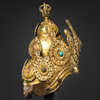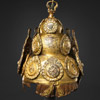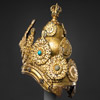Crowns of the Vajra Masters: Ritual Art of Nepal
Vajracarya Priest's Crown
Nepal, dated 1717
Gilt copper alloy inlaid with semiprecious stones
H. 12 in. (30.5 cm); W. 7 1/2 in. (19.1 cm); D. 6 3/4 in. (17.1 cm)
Gift of Lynne and Robert Rubin, 1985
The Metropolitan Museum of Art, 1985.13.2
This crown is dominated by five decorative lotus plaques, with two smaller floral bosses and no figurative elements, which is consistent with other crowns of this type. The absence of the usual bodhisattva representations points to its likely use as a crown for a Buddha or other Vajrayana deity. However, the thunderbolt (vajra) finial indicates it was to be worn by a Vajracharya priest, which the dated inscription confirms, stating that it was commissioned by two named devotees for the priest officiating the consecration of newly installed icons of Chakrasamvara and Heruka, in a ceremony performed at Naka Bahicâ, likely a branch of the Obâhâ monastery in Patan.
Elaborate crowns such as this example were worn by the hereditary Vajracarya Buddhist priests of Nepal, who occupy the highest rank in the Nepalese Buddhist community. Vajracarya is both a caste and a family name, and the designation entitles it holders to perform reserved priestly functions, analogous to the privileges held by Brahmans in Hinduism. This crown is dominated by five diadem plaques and surmounted by a half-vajra. The dated inscription records that it was commissioned by two named devotees, to be worn on the occasion of the consecration of newly installed icons of Chakrasamvara and Heruka. The consecrations were performed by srī Bekhāsi deva Vajrācārya of Naka Bahicā of OBāhā, "on Thursday, the 10th of the dark half of Bhādra, during the Pusyā naksatra and the Siddha yoga" (1717). The inscription concludes by listing the punishments incurred by those who covet the crown as well as the merits earned by its donors, extolling: "[May it be] auspicious for all time."
Inscription: Inscription on the back of a Vajarācārya's crown:
Transliteration:
1. samvat 837 bhādrava krsna dasmi-
2. yātithau pusya naksatra siddhi yogya
3. vrhaspativālasare yate dine jhīkhā (sā?)
4. ci kutra virathābhuka siddha guhasi
5. srī 3 cakrasamra srī 3 hyeruka dayakam thā
6. panā yānā thva pratistāsa o bāhā na-
8. si devajuyāta srī ratna mukuta sakalya
9. yānā juro, thvateyā jojamāna, obāhā
10. rakuna cheyā, vi (ci?) tāmuni, sayau torayā pakhā
11. cheyā ratna muni deva, maduri pa (ya?) nāsva (mva) la naniyā nala
12. siha deva, thvate somha samucayana, dohorapā, thva makuta sunāna lobha
13. yātasa pamca mahā pāpa rāka juro. thvatiyā jojamāna yāryathā sāttrapha-
14. ti subha mamgara sarvvadā
Translation: On Thursday, the 10th of the dark half of Bhādra, during the Pusyā naksatra and the Siddha yoga, the ...image(s?) of srī 3 Cakrasamvara (and?) sri 3 Heruka was/were made and consecrated by srī Bekhāsi deva Vajrācārya of Naka Bahicā of OBāhā; (for this consecration) this jewelled crown was made by his clients, Vitāmuni of OBāhā, rakuna che; Ratnamuni deva of Pakhā che (wall house) in Sayau tole; and Nala siha deva of Maduri panāsvala nani; these three he offered it together: Whoever covets this crown, may he incur the results of the five great sins. (As a result of the merit of this act, may the donors obtain...) (May it be) auspicious for all time.
(Trans. by Ian Alsop, Santa Fe, 19 July 1992)
Exhibition History
New York. The Metropolitan Museum of Art. "Art of the Himalayas," December 15, 2010-December 4, 2011.
New York. The Metropolitan Museum of Art. "Crowns of the Vajra Masters: Ritual Art of Nepal," December 16, 2017-December 16, 2018.



